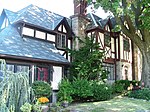Holy Cross High School (Queens)

Holy Cross High School is a co-educational Catholic high school located in Flushing, in the New York City borough of Queens. Formerly a boys' school, the school began to admit girls from the 2018–19 academic year. Founded in 1955, Holy Cross High School was chartered by the Board of Regents of the University of the State of New York and accredited by the Middle States Association of Colleges and Schools. Located within the Roman Catholic Diocese of Brooklyn, the school is sponsored by the Brothers of Holy Cross. There is a 98% college placement rate. The School's team is the Holy Cross Knights and the school's athletic archrival is the St. Francis Preparatory School Terriers. Since they are both located on Francis Lewis Boulevard approximately 2.5 miles (4.0 km) apart, when they play each other the game is called the Battle of the Boulevard.
Excerpt from the Wikipedia article Holy Cross High School (Queens) (License: CC BY-SA 3.0, Authors, Images).Holy Cross High School (Queens)
170th Street, New York Queens County
Geographical coordinates (GPS) Address Nearby Places Show on map
Geographical coordinates (GPS)
| Latitude | Longitude |
|---|---|
| N 40.771111111111 ° | E -73.795277777778 ° |
Address
170th Street 27-49
11358 New York, Queens County
New York, United States
Open on Google Maps







